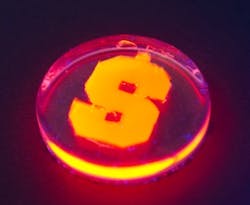Syracuse University scientists create firefly-enzyme-based bioluminescent nanorods
Syracuse, NY--Researchers at Syracuse University (SU) have found a new way to harness luciferase and luciferin—which fireflies rely on to produce their bioluminescence—to efficiently produce light in the lab. Their technique is 20 to 30 times more efficient than those of previous experiments.
It's all a result of the size and structure of the custom quantum nanorods that are produced in the laboratory by Mathew Maye, assistant professor of chemistry in SU’s College of Arts and Sciences; and Rebeka Alam, a chemistry Ph.D. candidate. Maye is also a member of the Syracuse Biomaterials Institute.
“We’ve found a new way to harness biology for nonbiological applications by manipulating the interface between the biological and nonbiological components," says Maye. Collaborating on the research were Professor Bruce Branchini and Danielle Fontaine, both from Connecticut College (New London, CT).
Their work, “Designing Quantum Rods for Optimized Energy Transfer with Firefly Luciferase Enzymes,” was published online May 23 in the American Chemical Society's Nano Letters and is forthcoming in print.
In Maye’s laboratory, luciferase is attached to the nanorod’s surface of the nanorods; luciferin, which is added later, serves as the fuel. The energy released when the fuel and the enzyme interact is transferred to the nanorods, causing them to emit light. The process is called bioluminescence resonance energy transfer (BRET).
Semiconductor shell/core structure
The nanorods have a shell of cadmium sulfide and a core of cadmium selenide. Manipulating the size of the core, and the length of the rod, alters the color of the light that is produced. The colors produced in the laboratory are not possible for fireflies. Maye’s nanorods glow green, orange, and red, while fireflies naturally emit a yellowish green. The efficiency of the system is measured on a BRET scale. The researchers found their most efficient rods (BRET scale of 44) occurred for a certain rod architecture (called rod-in-rod) that emitted light in the near-IR range.
Maye’s and Alam’s firefly-conjugated nanorods currently exist only in their chemistry laboratory. Additional research is ongoing to develop methods of sustaining the chemical reaction—and energy transfer—for longer periods of time and to scale up the system. Maye believes the system holds the most promise for future technologies that will convert chemical energy directly to light; however, the idea of glowing nanorods substituting for LED lights is not the stuff of science fiction.
“The nanorods are made of the same materials used in computer chips, solar panels, and LED lights,” Maye says. “It’s conceivable that someday firefly-coated nanorods could be inserted into LED-type lights that you don’t have to plug in.”
Maye’s research was funded by a Department of Defense PECASE award sponsored by the Air Force Office of Scientific Research (AFOSR). The AFOSR and the National Science Foundation supported the work performed by Maye’s collaborators at Connecticut College.

John Wallace | Senior Technical Editor (1998-2022)
John Wallace was with Laser Focus World for nearly 25 years, retiring in late June 2022. He obtained a bachelor's degree in mechanical engineering and physics at Rutgers University and a master's in optical engineering at the University of Rochester. Before becoming an editor, John worked as an engineer at RCA, Exxon, Eastman Kodak, and GCA Corporation.
